Over the years, honey has been used as both food and medicine as it is rich in nutrients and offers several health benefits. There is however a lot of controversy on what type of honey is the healthiest.
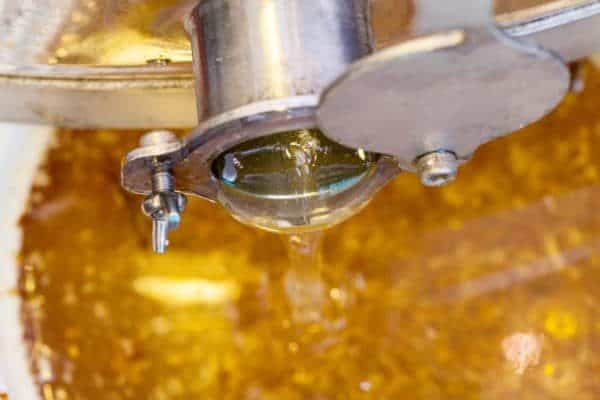
Most honey lovers prefer raw unfiltered honey over commercial honey, and here is why. What is raw unfiltered honey?
Raw unfiltered honey refers to honey that is not processed or filtered in any way. Such honey can be bought directly from local beekeepers. Since raw honey is not subjected to pasteurization and high temperatures, it is also called natural honey or pure honey.
This article will discuss in great detail how raw, unfiltered honey is different from commercial honey in terms of production, quality, and taste along with the risks and the benefits of using both kinds of honey.
How Is Commercial Honey Processed?
Honey produced commercially undergoes a series of processes before it is bottled, namely pasteurization and filtration.
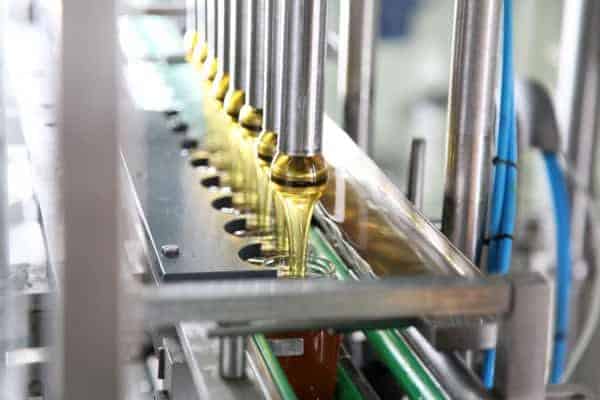
Pasteurization
Pasteurization includes heating the honey at a high temperature, nearly 70°C, or more. This process makes the honey thin and more fluid-like aiding in an easier filtration process. Pasteurization also extends shelf life and allows easy handling of the honey.
The disadvantage of pasteurization is that it removes natural aromas, nutrients, and beneficial enzymes present in raw honey.
Filtration
In addition to removing impurities and other substances like pollen, filtration makes the honey look aesthetically pleasing. As pollen and air bubbles are removed, the honey stays clear for longer periods.
Some manufacturers use an additional process called ultrafiltration. Just like its name, the honey is refined to make it smooth and transparent. The disadvantage of ultrafiltration is that it further removes beneficial nutrients, enzymes, and pollen.
Sweeteners
In addition to pasteurization and filtration, unethical manufacturers also add syrups or sweeteners to the honey. This helps to increase the taste of honey at a low cost. These sweeteners can lead to health problems, like weight gain, poor nutrition, and tooth decay.
Risks of Imported Honey
Canada, Thailand, China top the list of countries that import honey to the US.
The risk of imported honey is that we never know if it adheres to the rules put forward by the Food and Drug Administration (FDA) and the U.S. Department of Agriculture (USDA). Also, if the honey imported includes contaminants from flowers, it can lead to health problems.
The U.S. produces 200 million pounds of honey and consumes about 600 million pounds annually. This means that nearly 400 million pounds of honey are imported. The imported honey must adhere to the FDA and USDA regulations.
If you are wondering how many gallons of honey that is then we can help. Honey is heavier than water, in fact almost 50% heavier that water. This means the U.S. produces 16.66 million gallons of honey. For more on why honey weighs more than water check out this article we have written, How Much Does A Gallon Of Honey Weigh?
How Is Raw Unfiltered Honey Extracted?
Raw unfiltered honey is the honey that is present in the beehive. Even though raw honey does not undergo any kind of processing method, honey extraction is a long, tedious process. But the pure honey you get after extraction is worth the messy job.
Here is a step-by-step guide on how to extract raw unfiltered honey from the beehives.
Step 1: Protection
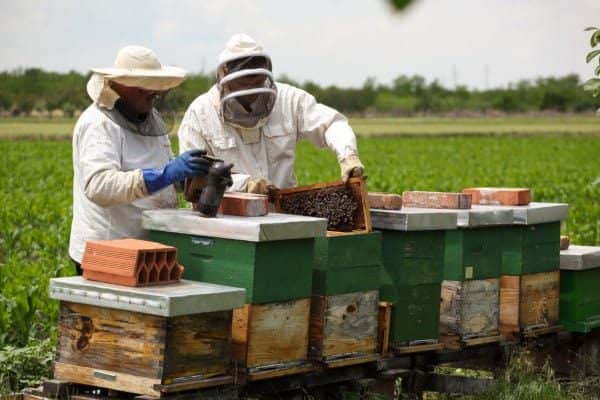
- Before going near a beehive to extract honey, make sure you wear protective clothing. A bee suit, a protective veil, hat, gloves, and protective footwear are necessary to avoid bee attacks.
- Beekeepers use a smoker to keep the bees calm and clear them from all the frames.
Step 2: Remove the Frames
Before removing the frames, see if the honeycombs are capped with wax cappings. If the cell of the honeycomb are not capped, it means that the honey is not ready for extraction.
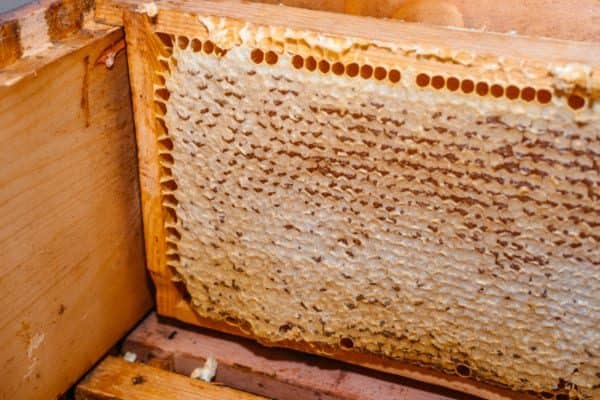
Using a bee escape board ahead of time will clear the bees from the frames without too much hassle.
If you are not using a bee escape board, you can smoke the frames before removing them to chase some of the bees off the frames of honey. Once you have the frame from the hive you can shake the frame and use a bee brush to brush off the remaining bees. Some beekeepers will even use a blower to remove the bees from the frames.
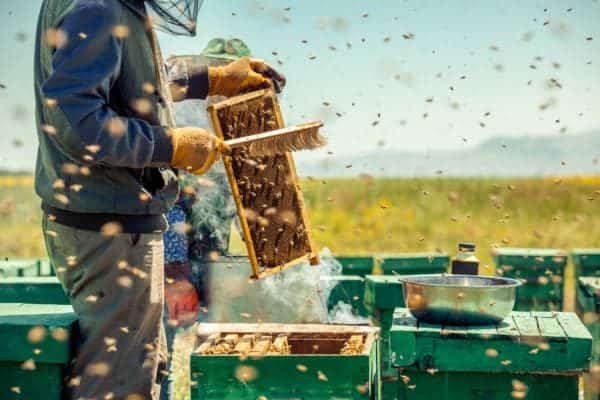
Once the bees are removed from the capped honey frames are taken to the extraction set-up, preferably a ventilated room that the bees cannot access.
Step 3: Remove the Wax Cappings
Use a heated knife, electric, or water/steam tool to slice down the frames to remove the wax cappings. This process is similar to slicing bread!
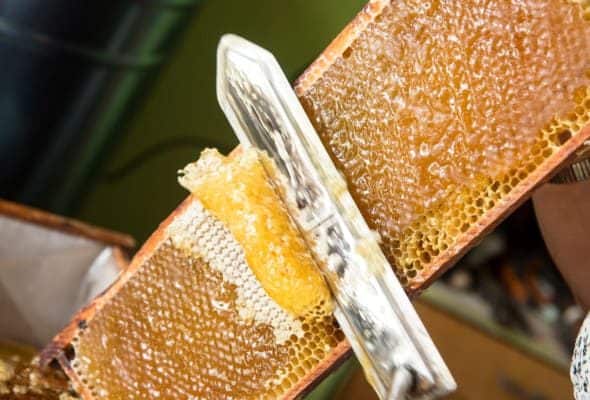
You can also use a fork-type tool to scrape the cappings on the cells missed by the knife. The idea is to remove the capping with minimum damage to the cell structure.
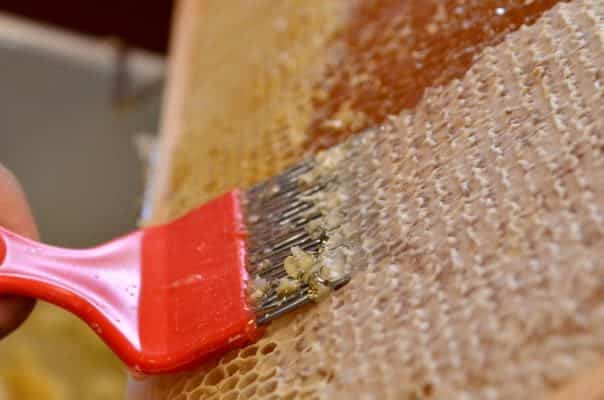
The best part about this process if you are doing it yourself is chewing on some fresh capping. The is no fresher raw honey than this. We talk mare about this in another article called, Can You Eat Honeycomb?
Step 4: Place the Frames in an Extractor
A honey extractor is a device that uses a centrifugal force to extract honey from the comb. It does not destroy the comb so that you can put the frame back in the beehive for the bees to refill it.
Place the frame vertically in the extractor and put the lid on. Start spinning the device slowly and build speed over time. Do not spin the frame too fast as it can damage the delicate comb. Continue the process for five to six minutes or until the comb is empty.
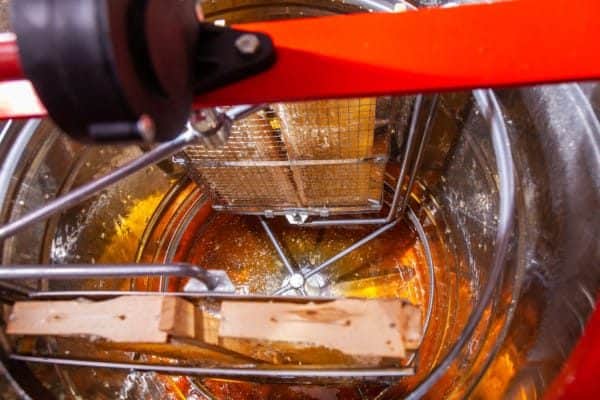
Note that the extractor should have a valve at the bottom. Once the honey is extracted, drain all of it from the valve of the extractor to a clean holding tank.
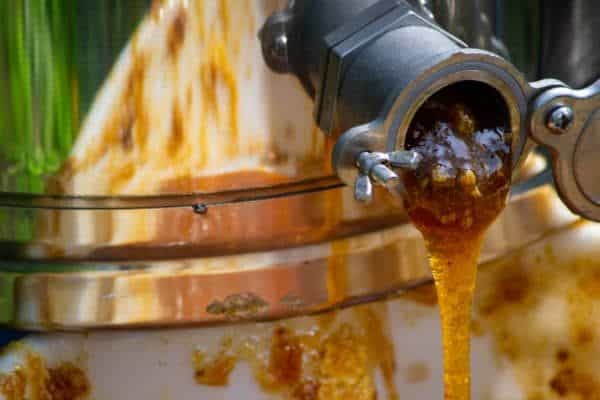
Step 5: Strain the Honey
You can use a kitchen strainer to remove wax, debris, and bee parts from the honey. Since this honey is not subjected to filtering, it will not lose its beneficial nutrients and antioxidants.
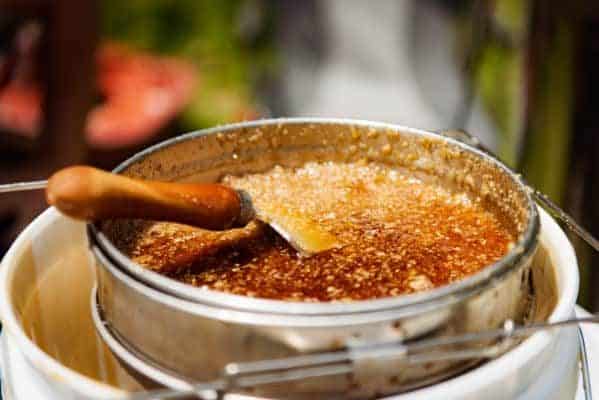
If you don’t have a strainer or you don’t want to strain the honey you can let it settle. All the debris floats slowly to the top. You can then decant the clean honey from a gate or tap at the bottom of the container or extractor.
When straining the honey spare a though for how many workers bees it has taken to produce the honey you see flowing before you. It is mind boggling how many bees it takes with one bee make about 1/12 of a teaspoon in its lifetime. For more on the check out this article we have written, How Much Honey Does A Honey Bee Make In Its Lifetime?
Step 6: Drain the Honey Into Sanitized Containers
Once the honey is free of debris and other unwanted materials, pour the honey from the holding tank into clean containers. It is better to use glass bottles instead of plastic bottles to store the honey.
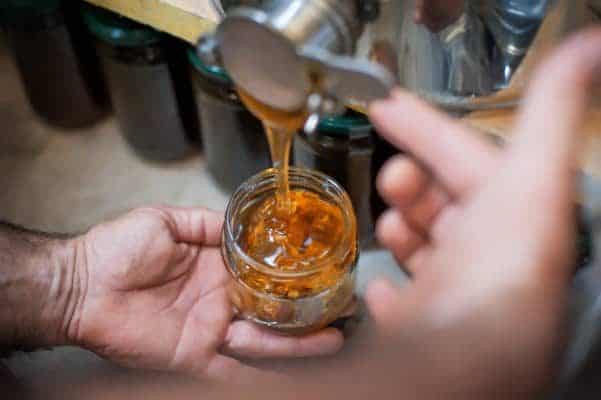
Raw Honey vs Regular Honey
As mentioned above, raw honey is extracted from the beehive and strained, whereas regular honey is processed through pasteurization and filtration. However, the difference between raw honey and regular honey is not just in the way they are obtained, but also in a few other aspects.
Raw Honey Is More Nutritious
Raw honey has a variety of nutrients and antioxidants that promote overall health. Since it does not undergo any kind of processing method, all the nutrients are retained in raw honey, making it more nutritious than commercial honey.
Furthermore, raw honey has plant compounds called polyphenols that are believed to reduce inflammation and lower the risk of heart diseases and certain cancers.
Commercial honey, on the other hand, contains very few antioxidants because it loses its nutrients when subjected to high heat during pasteurization.
Regular Honey May Have Hidden Sugars
Once the honey is extracted, most honey manufacturers will add artificial sweeteners to reduce costs. There is unquestionably a high demand for honey in the markets, so they can only meet the demands by adding hidden sugars, making the honey go further.
Adding sweeteners will greatly reduce the benefits of honey, the high calories in these additives can lead to weight gain and obesity. It can also increase the risk of diabetes and fatty liver disease.
Raw Honey Has Pollen
The pollen present in raw honey is very nutritious as it contains amino acids, vitamins, and antioxidants. Commercial honey loses the pollen content once it undergoes pasteurization and filtration.
Risks of Eating Raw Honey
We saw that raw honey contains nutrients and antioxidants that offer several health benefits. But there are also a few risks to consuming raw honey.
Both raw and regular honey contain spores of the bacteria Clostridium botulinum. This bacteria can cause a rare form of food poisoning, called botulism. Therefore, babies and children under one year should avoid using honey.
Most bacteria present in honey will die when subjected to high heat. As a result, commercial honey loses its bacteria content after pasteurization.
Conversely, raw honey has greater amounts of bacteria as it does not undergo any kind of processing. Raw honey is only strained after extraction, and straining separates only large particles and not microscopic bacteria.
While the risks of consuming raw honey are close to none, it is important to consult a doctor if you experience nausea or vomiting soon after eating raw honey.
If you are really interested in honey, then experiencing different varieties of honey is a must do. We have checked out a bunch of different types of honey if you want to check them out, 13 Honey Varieties You Should Discover
Frequently Asked Questions
1. How long does raw unfiltered honey last?
If stored properly, raw unfiltered honey can last around two years. Although honey is the only food that is said to last forever, it can undergo natural changes like loss of color, aroma, and flavor due to changes in temperature and moisture.
Honey can stay good for decades, but most honey products are said to last for two years.
If you are interested we have written an entire article about this subject. The article is called, Does Honey Expire?
2. Is raw and unfiltered honey safe?
It is safe to consume raw and unfiltered honey. When compared to regular or commercial honey, raw honey has greater amounts of a bacteria called Clostridium botulinum that can cause a rare form of food poisoning.
While this is mostly harmless for humans, babies and children under one year should refrain from consuming honey.
3. How is unfiltered honey not full of contaminants like wax, pollen, or bees?
After the honey is extracted from the beehives, it is passed through a strainer to remove debris and bee parts. The unwanted substances will settle in the strainer top, and we get clean raw and unfiltered honey. However, raw honey is not completely free of pollen as it does not undergo filtration or ultrafiltration like regular honey.
4. Is raw unfiltered honey the same as organic honey?
Raw unfiltered honey is not the same as organic honey. Raw honey is honey that has not been pasteurized and filtered. Organic honey is the honey that comes from a bee farm following the standards of the USDA.
Like the names suggest, raw means not filtered or heated, whereas organic means free of chemicals and antibiotics.
5. Does raw unfiltered honey need to be refrigerated?
Raw unfiltered honey does not need to be refrigerated. It does not contain artificial sweeteners, due to which it does spoil or crystallize. Store raw unfiltered honey in a tightly sealed container, preferably in glass containers as the metal ones can cause the honey to oxidize. Keep it in a cool place away from direct sunlight.
The Wrap Up
Experts suggest using raw honey over commercial honey as raw honey is rich in nutrients and antioxidants that can bring about several health benefits. Commercial honey loses half of its nutrient content as it undergoes pasteurization and filtration.
Raw honey is simply extracted out of the beehive and strained using a kitchen strainer. Therefore, it does not lose its nutrient and pollen content. However, the bacteria content in raw honey is slightly greater than in regular honey.
The higher bacteria content in raw honey is not a significant problem due to the number of antioxidants and nutrients present in raw honey. Please note that babies and children under one year should avoid consuming both raw and regular honey.
Did you know that there are other insects apart from honey bees that make honey? We have written some articles about them, find out if you can eat the honey they make. Links are below:
Do Wasps Make Honey? (Hint: One Species Does)
Vulture Bees: There Are Meat Eating Bees And They Make Honey
Carpenter Bees Vs Bumblebees Vs Honey Bees
Sources
https://www.healthline.com/nutrition/raw-honey-vs-regular#TOC_TITLE_HDR_8
https://usacustomsclearance.com/process/importing-honey-to-usa/
https://www.healthline.com/nutrition/10-benefits-of-honey
https://www.fda.gov/food/food-imports-exports/importing-food-products-united-states
